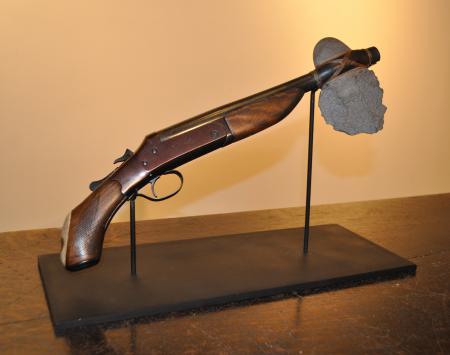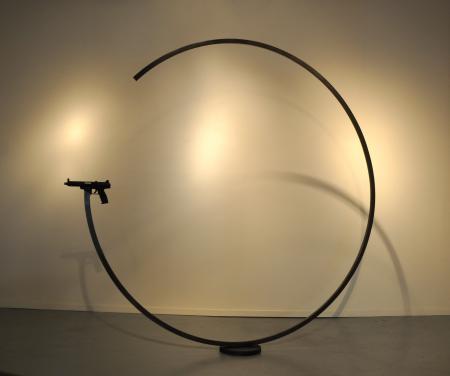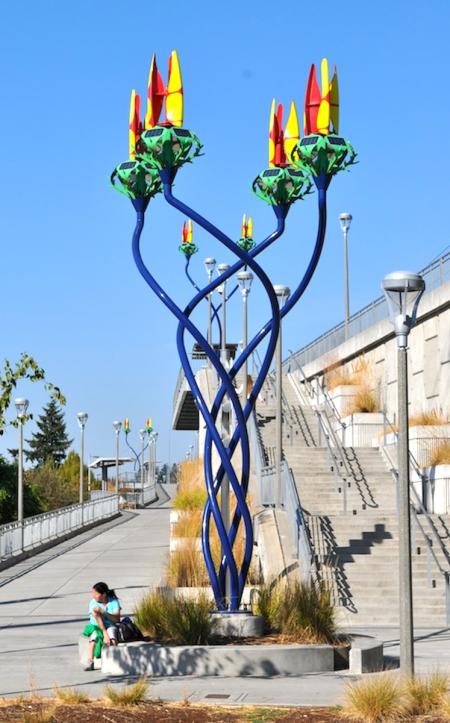Brian Borrello
Guns in the Hands of Artists


Art of the Gun
Brian Borrello’s work has always played with danger, whether it involved performance art like sleeping with pythons in an art gallery or dangling from a crane. This month the Portland resident returned to his native New Orleans for the latest installation of Guns in the Hands of Artists, a show where artists give makeovers to weapons seized by or surrendered to the police. Brian’s show will coincide with Prospect 3, New Orleans’ international contemporary art biennial.
His first Guns in the Hands of Artists launched in New Orleans in 1996. Most people Brian knew had guns in their nightstands. Ladies carried derringers in their purses. While New Orleans has an especially dangerous reputation, Brian found that Americans’ attachment to their guns was something systemic in the culture. “As Americans, there is this sense that violence is one way of resolving a dispute,” he said. “If you turn on a TV show or watch a Hollywood movie, there comes a point for the hero to pull out a gun. This idea that a handgun has to be part of every plotline made me think this paradigm needs to shift.”

Brian worked with New Orleans gallery owner Jonathan Ferrara and the New Orleans Police Department on both the 1996 and 2014 Guns in the Hands of Artists shows. For the first show, they got a donation of 100 new sewing machines. Then they organized a police buy-back of guns. “So bring in a gun, you get a new sewing machine,” Brian said. “Bring in a weapon, get a tool for creation.”
The police department welded the guns shut and cut off the firing pins. Then artists transformed them into sculptures, tapestries, rosaries and poetry. The show got lots of media attention and inspired other gun-themed art shows around the world. Brian later launched similar shows in Washington, DC and Portland.
In 2000, Brian made a public art piece for Shreveport called “Comfort Concealed.” It depicted an oversized kitchen table and chairs, with handguns, derringers and an AK47 welded beneath. “Really gnarly weaponry, painted glossy black,” Brian said. Doing gun-related pieces makes him feel like an alchemist, turning lead into gold. Brian appreciates the potent symbolism of the gun, and its aesthetic value. “It’s got power and sort of a sleek, deadly beauty to it.”
For the current show, Brian got to handpick about 200 guns from the New Orleans Police Department’s evidence room. So what kind of guns make good candidates for art?
“I try to think like an artist, see what’s significant in terms of form and material,” he said. “A lot of these weapons are really shit. Plastic, composites, not well made. A lot of them are not trusty and reliable. What I look for is quality, construction, something you can do something with, like something that’s got a big barrel or a nice wood grip.”
Not Just Guns
Guns are only one recurring theme in Brian’s work. He has an MFA from Arizona State and did post-grad work in architectural engineering. He welds, paints, draws, casts metal and works in neon.
Brian’s public art works dot the Portland landscape. He and artist Vanessa Renwick made the Zoobomb Pyle sculpture at W Burnside and 13th Avenue. His pieces at MAX stations include “Silicone Forest” at the Rose Garden and “Lents Hybrids” at Lents. “Silicone Forest” consists of giant solar-powered trees illuminated by LEDS. Their batteries are stored in stump seats that are configured around a virtual campfire. The hybrids feature flowers that are both wind turbines and solar panels. They generate power by day and illuminate by night. Passers-by can see them spinning from the freeway.
Brian realizes that many people will only get a glimpse of his art while they fly by at 65 mph. “When you’re doing work in a transportation setting like this, it’s difficult to create an intimate experience,” he said. So he works in layers. “If you get out and look closer, there’s something to be revealed that gives you a sense of deeper history and deeper context.”

“One of the things I do is figure out how to make more interesting places,” Brian said. “And particularly finding places that really have aesthetic deficits. Urban spaces that need some love, need some attention, excitement and interest.”
Don’t Settle
Brian doesn’t like to tell other artists what to do. “I’m hesitant to give advice as the wise sage,” he said. But when pressed, some of his views come across clearly.
First, Brian has worked hard to learn his crafts of welding, drawing, painting and making neon. “I have dedicated myself to try to be as skilled in my craft as I can be.”
Second, he believes each artist is a unique interpreter of the world with a personal vision to bring forth. “I think this is one of the highest pursuits that we can do as citizens of this world in this short time that we have here,” he said. He urges artist to consider themselves art warriors by moving artistic expression beyond traditional art world settings and into everyday experience. Too much of art has been watered down into work that looks good on a living room wall or a billboard, which diminishes the full impact of what artists traditionally have been, and what art can be. Brian would like to see artists regarded as more shamanistic and miraculous.
Artists need to seize opportunities. “If we’re not claiming space for beauty, for artistry, it will potentially be lost toward something commercial, something less meaningful. We need to act as missionaries to get our work out there.” Brian believes in using art as a forceful counterpoint to the forces of marketing and commercialization. “We need to be able to create things that aren’t beholden to art as currency, art as a tradable commodity.”
In other words, don’t settle.
“If you’re not making it interesting, question why you’re making it at all,” Brian said. “It’s almost our duty to make our world more interesting.”